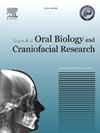The role of rhBMP-2 in mandibular bone regeneration following tooth extraction through HIF-1α and VEGF-A expression: An Immunohistochemical study
Q1 Medicine
Journal of oral biology and craniofacial research
Pub Date : 2025-02-13
DOI:10.1016/j.jobcr.2025.02.001
引用次数: 0
Abstract
Background
Dentists frequently conduct tooth extractions when there is damage to the tooth or the tissue that supports it. When a tooth is extracted, the alveolar bone will sustain injury. Most of the initial bone volume is lost following the healing phase after extraction. Rehabilitation must start as soon as a tooth is missing, mainly because the alveolar bone is severely damaged during the tooth extraction, particularly in the buccal region where the tooth is removed. Dental implant is one method of replacing lost teeth. One of the most important elements influencing the clinical result of dental implants is a change in the dimension of the alveolar bone. Several bone-grafting techniques, such as socket preservation techniques, have been developed to increase the volume of bone throughout the healing phase after tooth extraction. This study aims to assess the impact rhBMP-2 on creating bone regeneration through VEGF and HIF-1α in the mandibular socket post-extraction in Wistar rats.
Method
On the anterior side of the mandible, in the socket area where the tooth was extracted, rhBMP-2 was injected into the socket, and the xenograft material was applied with a syringe. Male, 9-week-old Wistar rats were chosen (n = 30).
Result
Our statistical evaluations have revealed a significantly higher VEGF-A and HIF-1α expression post-extraction of the rhBMP-2 and xenograft group compared to other group treatments. These findings are significant as they provide a deeper understanding of the mechanisms involved in bone regeneration post-extraction.
Conclusion
Our study suggests that injecting rhBMP-2 into the grafted material and socket extraction during GBR dramatically increases the expression of VEGF-A and HIF-1α. These findings have the potential to significantly impact oral surgery and regenerative dentistry, opening up new possibilities for enhancing bone regeneration techniques.
rhBMP-2通过HIF-1α和VEGF-A表达在拔牙后下颌骨再生中的作用:免疫组织化学研究
背景当牙齿或支撑它的组织受损时,牙医经常进行拔牙。拔牙时,牙槽骨会受到损伤。在拔牙后的愈合阶段,大部分初始骨体积丢失。一旦缺牙,康复必须尽快开始,主要是因为拔牙时牙槽骨严重受损,特别是在拔牙的颊区。植牙是替换掉的牙齿的一种方法。影响种植体临床效果的重要因素之一是牙槽骨尺寸的改变。一些植骨技术,如窝保存技术,已经发展到在拔牙后的整个愈合阶段增加骨的体积。本研究旨在评估rhBMP-2通过VEGF和HIF-1α对Wistar大鼠下颌牙槽拔牙后骨再生的影响。方法在下颌骨前侧拔除牙槽区注射rhBMP-2,用注射器注射异种移植物材料。选取9周龄雄性Wistar大鼠(n = 30)。结果统计分析显示,rhBMP-2和异种移植物组提取后VEGF-A和HIF-1α的表达明显高于其他组。这些发现具有重要意义,因为它们提供了对提取后骨再生机制的更深入理解。结论在GBR过程中,将rhBMP-2注射到移植物材料中并取出窝,可显著提高VEGF-A和HIF-1α的表达。这些发现有可能对口腔外科和再生牙科产生重大影响,为增强骨再生技术开辟了新的可能性。
本文章由计算机程序翻译,如有差异,请以英文原文为准。
求助全文
约1分钟内获得全文
求助全文
来源期刊

Journal of oral biology and craniofacial research
Medicine-Otorhinolaryngology
CiteScore
4.90
自引率
0.00%
发文量
133
审稿时长
167 days
期刊介绍:
Journal of Oral Biology and Craniofacial Research (JOBCR)is the official journal of the Craniofacial Research Foundation (CRF). The journal aims to provide a common platform for both clinical and translational research and to promote interdisciplinary sciences in craniofacial region. JOBCR publishes content that includes diseases, injuries and defects in the head, neck, face, jaws and the hard and soft tissues of the mouth and jaws and face region; diagnosis and medical management of diseases specific to the orofacial tissues and of oral manifestations of systemic diseases; studies on identifying populations at risk of oral disease or in need of specific care, and comparing regional, environmental, social, and access similarities and differences in dental care between populations; diseases of the mouth and related structures like salivary glands, temporomandibular joints, facial muscles and perioral skin; biomedical engineering, tissue engineering and stem cells. The journal publishes reviews, commentaries, peer-reviewed original research articles, short communication, and case reports.
 求助内容:
求助内容: 应助结果提醒方式:
应助结果提醒方式:


